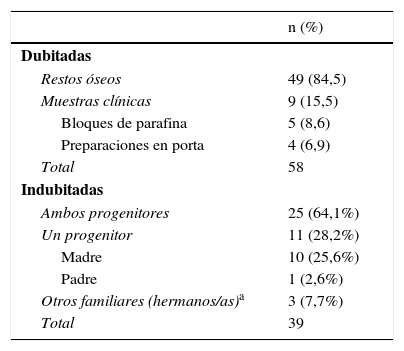Los casos de adopciones irregulares y sustracción de recién nacidos en España han tenido una gran repercusión social, lo que ha conllevado la elaboración de reformas normativas y el desarrollo de guías y recomendaciones científicas que ayuden a su investigación. El objetivo del presente estudio fue la identificación genética de las muestras remitidas mediante estudios de parentesco.
Material y métodosEntre 2011-2014 se recibieron en el Departamento de Barcelona del Instituto Nacional de Toxicología y Ciencias Forenses 58 casos sobre los que se requirió judicialmente un estudio de identificación genética. Se analizaron restos óseos exhumados o muestras clínicas. Tras el estudio previo (antropológico y anatomopatológico) se procedió a la extracción del material genético y su posterior análisis.
ResultadosLa calidad y cantidad del ADN recuperado permitió el análisis genético en el 67,2% de los casos, frente al 32,8% donde no fue posible. Los datos muestran que mayoritariamente (87,2%) se estableció una relación de compatibilidad paterno-filial, siendo minoritarias las exclusiones (12,8%). El índice de verosimilitud osciló entre 1,75×104-5,95×1017 y los STR estudiados de 8-21.
ConclusionesLos datos y experiencia adquirida muestran la importancia de la recopilación de la información, de los antecedentes del caso y del estudio antropológico previamente al análisis genético. Esta información permite orientar los estudios genéticos y, ocasionalmente, ayuda a interpretar los resultados. Asimismo, las características de este tipo de muestras obligan a establecer un protocolo de calidad que garantice la autenticidad de los resultados finales.
Cases of irregular adoptions and abduction of newborns in Spain have had got a great social impact which has led to regulatory reforms and the implementation of scientific guidelines and recommendations to help their investigation. The objective of the study was the genetic identification of the samples submitted by kinship studies.
Materials and methodsIn the period between the year 2011 and 2014, the Barcelona Department of the National Institute of Toxicology and Forensic Sciences,received a total of 58 cases on which it was judicially required to carry out a study of genetic identification. Exhumed bones or clinical samples were analyzed. After previous study (anthropological, anatomo-pathological), the extraction of genetic material and its subsequent analysis were carried out.
ResultsThe quality and the quantity of recovered DNA allowed carrying out genetic analysis in 67.2% of cases, compared to 32.8%, where it was not possible. The data show that for the majority ofthe cases studied (87.2%) was established a positive relationship, being minority the cases of exclusion (12.8%). The likelihood ratio (LR) obtained, ranged from 1.75×104-5.95×1017, and the STR markers studied from 8 to 21.
ConclusionsExperience and data show the importance of gathering information, the history related to the caseand the importance of the anthropological study prior to genetic analysis. This information allows orienting the genetic studies and, in some cases, it helps to interpret the results. Also, the characteristics of this type of samples require establishing a quality protocol that ensures the authenticity of the final results.
Artículo
Comprando el artículo el PDF del mismo podrá ser descargado
Precio 19,34 €
Comprar ahora







